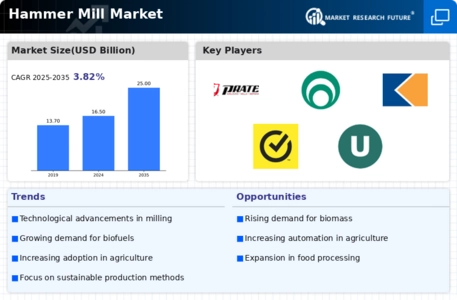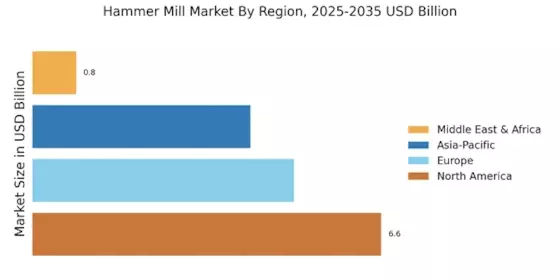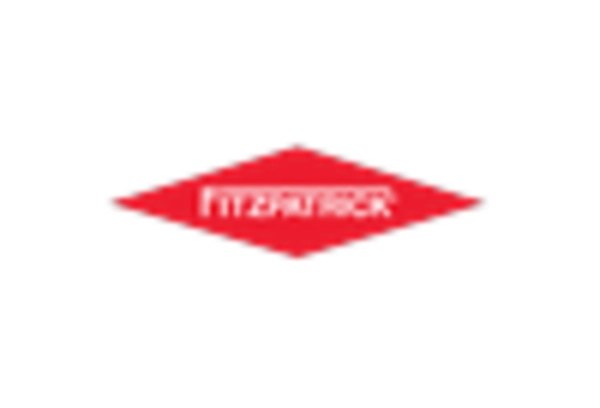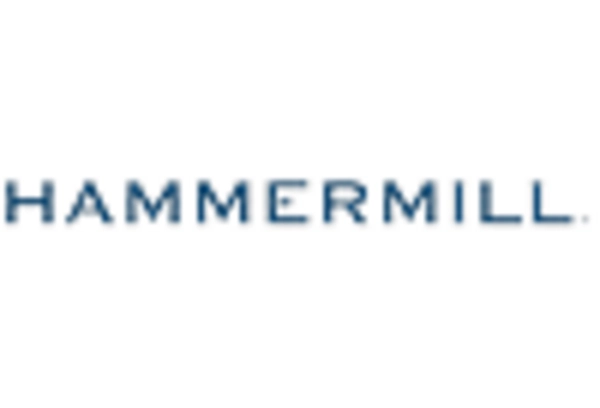Growing Biofuel Production
The Hammer Mill Market is witnessing a surge in demand driven by the increasing production of biofuels. As countries strive to reduce their carbon footprints and transition to renewable energy sources, the need for biomass processing has escalated. Hammer mills are instrumental in converting agricultural residues and other biomass materials into suitable feedstock for biofuel production. The biofuel market is projected to expand significantly, with estimates suggesting a growth rate of around 6% annually. This trend is likely to create new opportunities for hammer mill manufacturers, as they cater to the evolving needs of the biofuel sector.
Rising Demand for Animal Feed
The Hammer Mill Market is experiencing a notable increase in demand for animal feed production. As livestock farming continues to expand, the need for efficient feed processing solutions becomes paramount. Hammer mills are essential in grinding grains and other feed ingredients, ensuring optimal nutrition for livestock. According to recent data, the animal feed sector is projected to grow at a compound annual growth rate of approximately 4.5% over the next few years. This growth is likely to drive the demand for hammer mills, as producers seek to enhance feed quality and reduce processing costs. Furthermore, the trend towards high-protein diets for livestock is expected to further bolster the hammer mill market, as these machines are crucial for processing protein-rich feed components.
Increased Focus on Food Safety
Food safety remains a critical concern within the Hammer Mill Market, particularly in the processing of grains and other food products. The stringent regulations surrounding food safety and quality assurance are compelling manufacturers to invest in advanced milling technologies. Hammer mills play a vital role in ensuring that food products are free from contaminants and meet safety standards. The market for food processing equipment, including hammer mills, is anticipated to grow significantly, driven by the need for compliance with food safety regulations. As consumers become more health-conscious, the demand for safe and high-quality food products is likely to increase, thereby enhancing the hammer mill market's growth prospects.
Expansion of the Construction Industry
The Hammer Mill Market is also benefiting from the expansion of the construction sector, which requires various materials for building and infrastructure projects. Hammer mills are utilized in the processing of materials such as aggregates, wood chips, and other construction-related inputs. As urbanization accelerates and infrastructure development projects increase, the demand for processed materials is expected to rise. This trend is likely to drive the hammer mill market, as construction companies seek efficient solutions for material processing. The construction industry's growth is anticipated to contribute positively to the overall demand for hammer mills in the coming years.
Technological Innovations in Milling Equipment
Technological advancements are reshaping the Hammer Mill Market, leading to the development of more efficient and versatile milling equipment. Innovations such as automated controls, energy-efficient motors, and advanced grinding technologies are enhancing the performance of hammer mills. These improvements not only increase production efficiency but also reduce operational costs for manufacturers. The integration of smart technologies, such as IoT and data analytics, is expected to further optimize milling processes. As the industry embraces these innovations, the demand for modern hammer mills is likely to rise, reflecting a shift towards more sophisticated and capable milling solutions.


















Leave a Comment